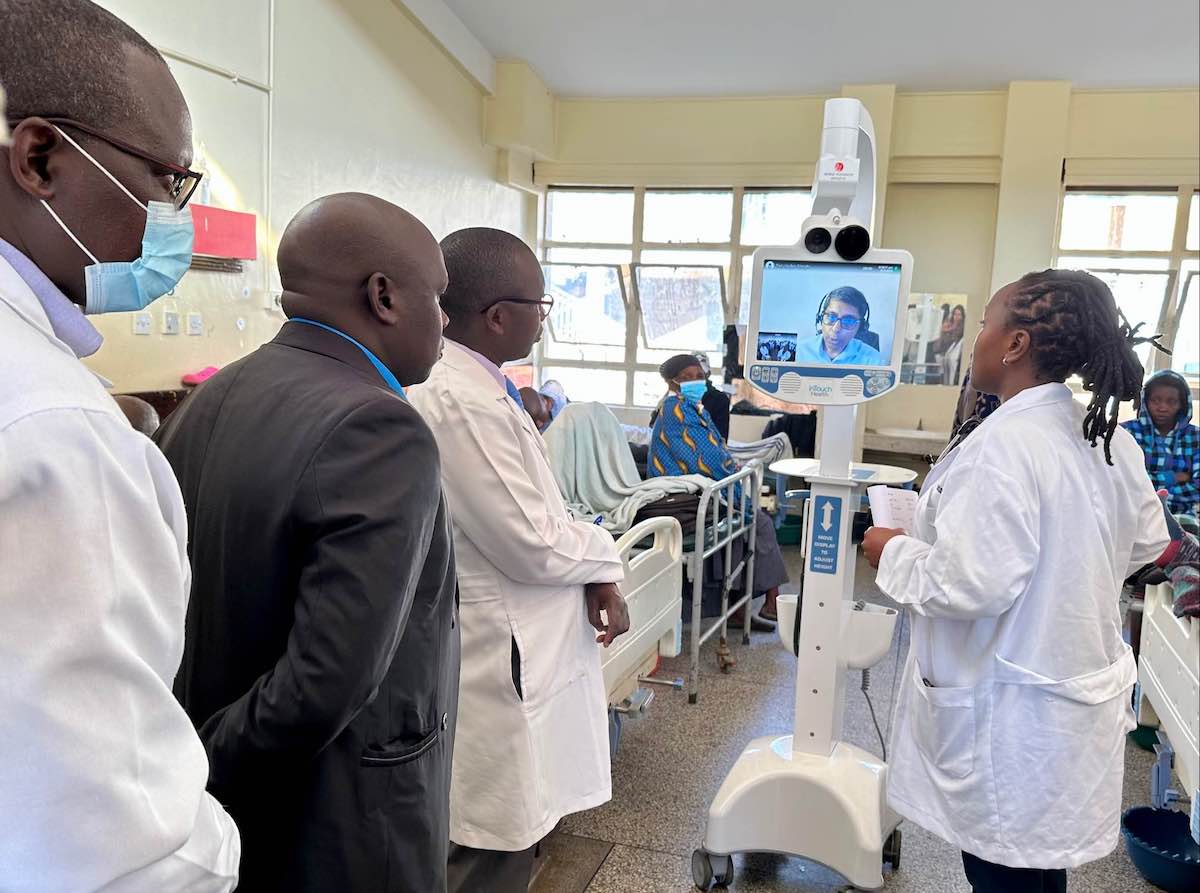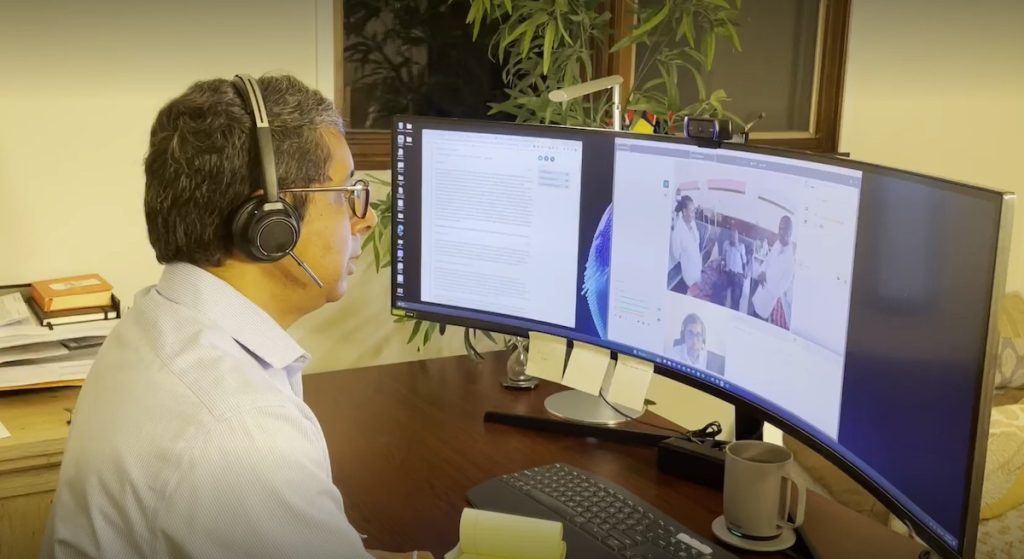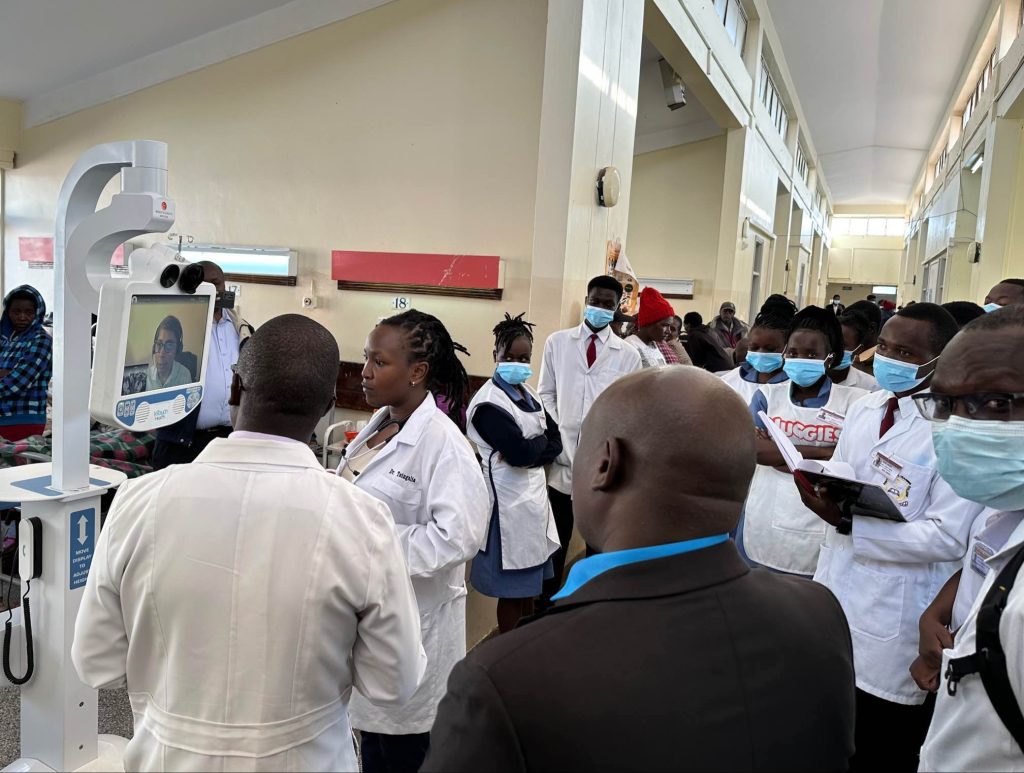Connecting Doctors to Underserved Communities and Career Fulfillment Across the Globe

World Telehealth Initiative had a very lofty goal when the nonprofit began in 2017: use modern medical robotics and engage volunteer physicians to make an impact in healthcare disparity across the globe. With half of the world’s population lacking access to essential health services, statistics show that nearly nine million people die every year from conditions that are treatable, a result of either substandard healthcare or none at all.
Co-founded by Teladoc Health’s Dr. Yulun Wang, the pioneering inventor of the first FDA-cleared surgical robot, and prior corporate CEO Sharon Allen, World Telehealth Initiative utilizes Teladoc-donated medical robotic devices to allow volunteer physicians to remotely evaluate patients and consult with on-site clinicians across the world. The robots have high-definition cameras with 26X magnification capabilities for detailed close-up exams, as well as plug-in diagnostic tools to support the delivery of care where and when it is needed most.
“It’s just amazing technology that provides an incredibly enhanced interaction,” said Allen. “You can attach a stethoscope and the provider in Santa Barbara can hear the heart, lung, or bowel sounds of that patient in Ethiopia. You can put an ultrasound on a pregnant mother, and the doctor here can see the live images simultaneously, so they can discuss with their colleague at the clinic in Malawi. They can tele-strate right on the image for augmented communication.”
The telehealth technology is not only extraordinarily easy to use, it also works on very low bandwidth, which is of paramount importance in developing nations and vulnerable communities, Allen said. “There have been a lot of times that the phone lines aren’t working or Zoom can’t connect, but our telehealth system does work.”
The RP-Lite robots (remote presence telemedicine carts from Teladoc) are on wheels, and can travel to different departments within a hospital to where they’re needed, or brought to a public center for a community health fair where they might help serve 300 patients in a day. WTI’s volunteer clinicians are there, remotely, to offer support, guidance, and collaboration, and advance the skill level of the on-site caregivers.

“The underlying goal is always to upskill that local provider so they can begin to care for more and more of their own community,” Allen explained.
WTI’s modern approach and unique program model is cost-effective and sustainable, as well as scalable to varying situations around the world. The volunteer medical specialists from WTI are able to support healthcare colleagues and their patients in low-resource hospitals and clinics all over the globe – providing expertise in patient diagnosis and treatment as well as mentorship and training for the on-site medical professionals – from the comfort of home or their own office, eschewing barriers of time, travel and cost.
With 50 RP-Lite life-sized robotic devices already in use around the world, and more on the way, WTI has been a game-changer in international health care.
What WTI hadn’t anticipated, however, was the level of impact the program would have on the volunteer doctors themselves, helping to tackle one of the most important issues in American healthcare these days: job satisfaction and employee retention.
Enter Ron Werft.
With clinician burnout a rising problem for hospitals across the country even after the pandemic has subsided, stemming the tide is a focus for Werft, President and CEO of Cottage Health, who is also an active board member at WTI. Werft came up with the idea to create the World Telehealth Initiative membership program for hospitals and other health organizations, which streamlines the process for doctors to sign up to volunteer while also providing a source of recurring revenue to sustain the nonprofit.
Werft was already familiar with WTI’s work and its value for vulnerable communities. But hearing about the experiences of the volunteer physicians proved revelatory.
“These are doctors who are extremely busy, with very active professional lives who were volunteering with WTI maybe just an hour a week or two hours a month,” he said. “But they all said it was incredibly meaningful, one of the best things they’ve ever done. There’s no administration, just pure doctoring. And they’re not only providing vital care to a community, but they are helping to lift the skill level for future care delivered within that community. It was pure joy.”

The concept to create the program came about when Werft heard Dr. Tait Shanafelt, an MD and PhD researcher at Stanford who focuses on caregiver wellbeing and burnout, speak at a Cottage event in town. His data-driven conclusion was that if relatively small increases in a percentage of a caregiver’s time invested in doing meaningful work, there’s a dramatic reduction in burnout symptoms. And lots of other research has shown that volunteerism was by far the best thing to increase medical workforce wellness.
“That was the aha moment for me,” Werft said. “The WTI telehealth model is 100 percent at the remote bedside – no time spent on documentation or updating the electronic health record or insurance forms, or any of those types of tasks. They’re able to just set that aside and do what they do best. There’s a lot of joy and incredibly meaningful work in applying their skills and making a dramatic difference in a country that would not otherwise have access to advanced healthcare.”
The membership program is still in its infancy, but a number of healthcare systems across the country have signed on, helping to acquaint their doctors to WTI’s opportunities and financially supporting the nonprofit for similar dollars they might spend for a motivational speaker.
“There’s a study out of UCLA that shows that 80 percent of providers want to engage on a humanitarian level,” Allen said. “But finding these meaningful volunteer opportunities is actually not very easy. We make it very easy. Providers simply enter their medical specialty, the hours they want to work, the countries they’re interested in, and whether they want to do clinical consultations with partners abroad or simply offer didactic lectures. Whenever one of our partners around the world makes a request, if it matches to them, they get a notification and choose whether to volunteer. With our method they can work with our telehealth program as little as one hour a month, and still get that intense feeling of fulfillment.”
Werft said the membership program is an efficient benefit to hospitals, including at Cottage Health, which he leads and where Dr. Andrew Gersoff, who recently retired as the director of the Internal Medicine Residency program, will serve as medical administrator coordinator for the WTI program.
“He’ll be speaking at general medical staff meetings, going to department meetings and sharing the story,” he said. After two years of retirement, Dr. Gersoff is excited to be taking on this meaningful role to benefit both physicians and communities in need.” Cottage expects more physicians engaged in global health.
Allen remarked that people in the Santa Barbara community as a whole will benefit from Cottage being involved with WTI.” It’s strengthening your home healthcare system,” she said. “If your providers are fulfilled and excited about their profession and eagerly waiting to serve you, that is really a benefit for everybody.”
Visit www.worldtelehealthinitiative.org for more information





